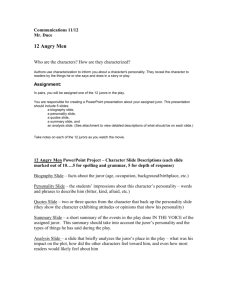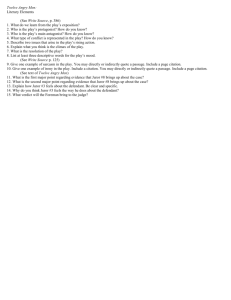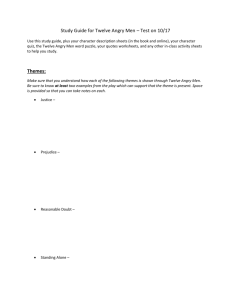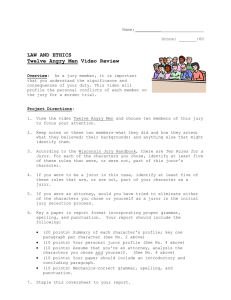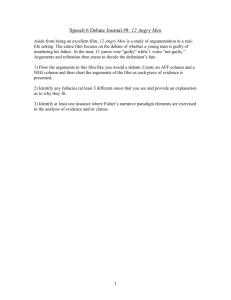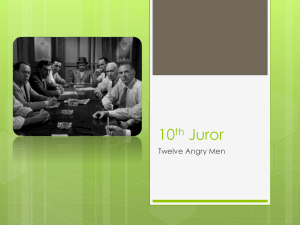12 Angry Men Character Analysis Project
advertisement
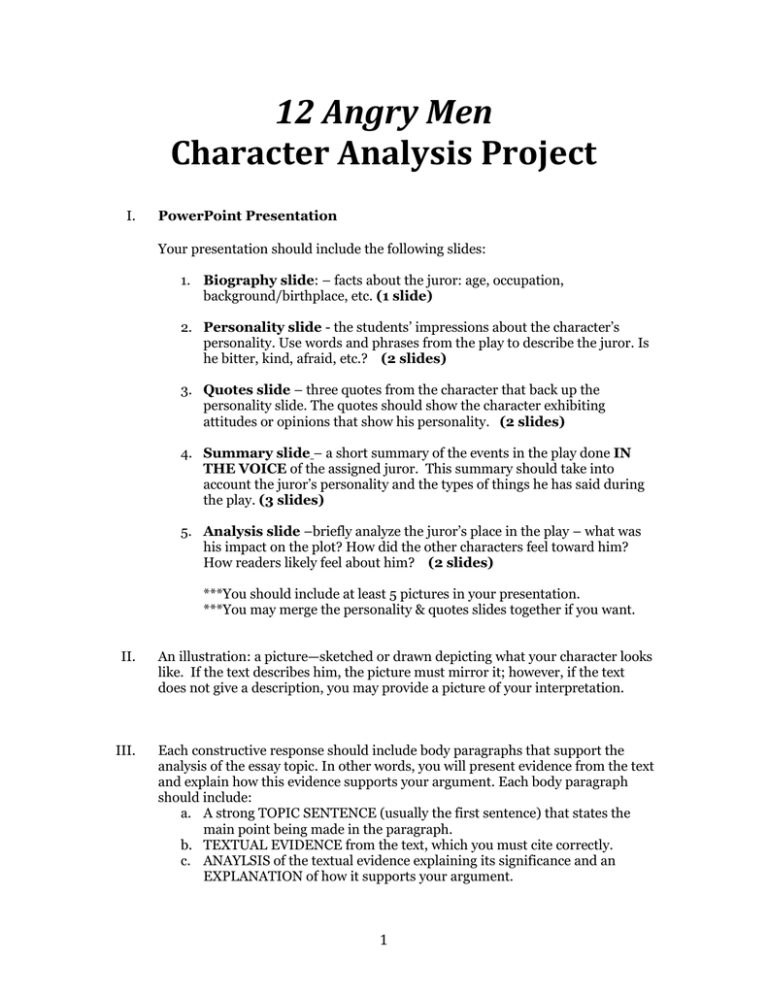
12 Angry Men Character Analysis Project I. PowerPoint Presentation Your presentation should include the following slides: 1. Biography slide: – facts about the juror: age, occupation, background/birthplace, etc. (1 slide) 2. Personality slide - the students’ impressions about the character’s personality. Use words and phrases from the play to describe the juror. Is he bitter, kind, afraid, etc.? (2 slides) 3. Quotes slide – three quotes from the character that back up the personality slide. The quotes should show the character exhibiting attitudes or opinions that show his personality. (2 slides) 4. Summary slide – a short summary of the events in the play done IN THE VOICE of the assigned juror. This summary should take into account the juror’s personality and the types of things he has said during the play. (3 slides) 5. Analysis slide –briefly analyze the juror’s place in the play – what was his impact on the plot? How did the other characters feel toward him? How readers likely feel about him? (2 slides) ***You should include at least 5 pictures in your presentation. ***You may merge the personality & quotes slides together if you want. II. An illustration: a picture—sketched or drawn depicting what your character looks like. If the text describes him, the picture must mirror it; however, if the text does not give a description, you may provide a picture of your interpretation. III. Each constructive response should include body paragraphs that support the analysis of the essay topic. In other words, you will present evidence from the text and explain how this evidence supports your argument. Each body paragraph should include: a. A strong TOPIC SENTENCE (usually the first sentence) that states the main point being made in the paragraph. b. TEXTUAL EVIDENCE from the text, which you must cite correctly. c. ANAYLSIS of the textual evidence explaining its significance and an EXPLANATION of how it supports your argument. 1 d. LINK BACK TO TOPIC in one or more statements, usually towards the end of the paragraph. e. CONCLUSION sentence that ties everything together and finishes the essay. It includes strong statements that emphasize your central argument and provide a clear response to the topic. IV. ESSAY TOPIC: The relationship between juror 3 and 8 is the most important element in 12 Angry Men. When answering essay questions, you will always need to provide support from the text, using specific events or quotes. This topic guides you towards relevant parts of the play on which to focus your examination. You will need to remember to use quotes and evidence from the text to support your arguments about the play as a whole. You may want to gather a list of important quotes and incidents for each of the two characters, as well as important moments between them. This will help you support your argument once you start writing. The second part of the question asks you to identify the most important aspect of the play—it would be useful to list other main elements in the play, such as: The notion of reasonable doubt Attitudes of prejudice Conflicts between jurors It will be helpful for you to argue for or against the topic and explain why. In this case, you see that juror 3 & 8’s relationship actually illustrates all the important issues. Sample introduction: There are many elements of 12 Angry Men that serve to address the text’s themes of decision-making and legal justice. Reginald Rose uses these various elements to challenge his audience to consider issues, such as what influences our decisions and whether the justice system is fair and ethical. These elements include themes of prejudice and the validity of witness testimony, as well as the shifting dynamics between jurors. While reasonable doubt, prejudice and jury-room conflict can be identified as central issues in the play; the most important element is the relationship between juror 3 and 8. The development of this relationship drives the action of the play and encompasses all of Rose’s central themes. 2 Paragraph Breakdown Introduction-- Restate the prompt and add in your own commentary. Use notes from page 2 to guide you. Provide a thesis statement that encompasses the ideas in your paper. Body Paragraph 1--- Introduce the relationship between juror 3 & 8 explaining why it is a central theme of the play. Briefly describe the two characters individually before discussing their relationship Summarize the nature of the relationship, including the character’s similarities, differences and specific interactions, such as physical incidents. Explain how the relationship fits into the play as a whole---for example include the three incidents that are representative of important parts of the climax. Briefly comment on how aspects of their relationship support important themes and ideas in the play Body Paragraph 2--- Contextualize this relationship beside other important elements of the play (particularly those mentioned in the introduction). Discuss the notion of reasonable doubt—explain what it means, reference discussions from the text. Discuss attitudes of prejudice, using examples from other juror’s speech. Discuss the jury-room conflicts using direct evidence from the text, including disagreements over the case and personal conflicts. 3 Body Paragraph 3--- Explain how this relationship illustrates all other important elements of the play. Juror 8 is the character who most clearly understands ‘reasonable doubt’ and Juror 3 is the least willing to accept it. This clash in their relationship represents the struggle to come to terms with the concept of reasonable doubt. Show how juror 3 and juror 8 represent extremes. Juror 3 is prejudice & stereotypical while juror 8 is more balanced opinions. How does their relationship embody the aspects of prejudice on decisions and interactions? Reference specific instances of conflict between juror 3 and 8, such as the disagreement about what’s ‘possible’ and explain how these conflicts are primary examples of conflict that arise in jury-room situations. Conclusion -- Avoid simply restating the points made earlier in the essay—this will end on a flat note and imply you’ve run out of ideas. Conclusion should be a logical extension of what you’ve written, not just a summary of it. Think of two broad statements or observations about the text’s wider meaning. These should be related to the topic and your overall argument 4

